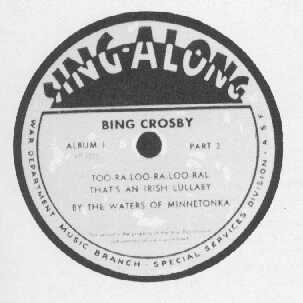A History of V-Discs

At the depth of World War II -- July 31, 1942 -- The American Federation of Musicians, headed by James C. Petrillo, went on strike to seek royalties from the record companies to finance an unemployment fund to compensate musicians who lost work because of competition from recorded music. The strike dragged on for more than a year, drastically reducing the production of new commercial recordings. Bing Crosby, for example, recorded no songs for commercial release during the first year of the strike.
The strike also cut off the supply of new recordings to the troops overseas. Robert Vincent, a sound engineer and a lieutenant assigned to the radio section of the Army Special Services Division, approached the War Department with the idea of recording music especially for the troops. He received approval from Washington in July 1943 and was transferred to the music section of Army Special Services, where the V-Disc program developed.
Vincent set up shop at Third Avenue and East 42nd Street in New York City. His first order of business was to secure the blessings, including waiver of all fees and royalties, from recording companies and unions, including the striking American Federation of Musicians. To get these waivers the Army assured the unions that V-Discs would be for use of military personal only and would not be available commercially. Moreover, the unions were promised that V-Discs would not be declared military surplus but would be destroyed, along with the masters, when no longer of use to the armed forces.
Next Vincent had to secure a name for the project -- something more attractive than "Special Services Recordings." A secretary suggested V-Discs, the "V" standing for Victory as well as Vincent.
The first V-Discs were shipped Oct. 1, 1943, from the RCA Victor pressing plant in Camden, New Jersey. The initial shipment included 1,780 boxes each containing 30 records.
 A variety of sources were used for V-Discs: commercial recordings (both issued and unissued "alternate" takes), radio broadcasts, including some from the Armed Forces Radio Service, dress rehearsals of radio shows where no audience was present, film soundtracks, and special recording sessions, often at odd hours and including unusual combinations of musicians. On several occasions network broadcasts were arranged for the purpose of generating V-Disc material.
A variety of sources were used for V-Discs: commercial recordings (both issued and unissued "alternate" takes), radio broadcasts, including some from the Armed Forces Radio Service, dress rehearsals of radio shows where no audience was present, film soundtracks, and special recording sessions, often at odd hours and including unusual combinations of musicians. On several occasions network broadcasts were arranged for the purpose of generating V-Disc material.
V-Discs were larger than commercial 78rpm records -- 12 inches instead of 10 -- and were often cut with as many as 136 grooves per inch so that more than 6 minutes of music could be included. The standard commercial disc was limited to less than 4 minutes per side.
The V-Disc program survived both the musicians' strike and the War by several years. At the end of the War, Vincent left the army and recommended that the V-Disc program be discontinued. But production continued, although at a much reduced rate, until May 1949. During its 6-year run, the V-Disc program produced 900 unique discs containing 3000 separate recordings and shipped more than 8 millions discs overseas.
Although most of the unused V-Discs and their masters were dutifully destroyed, discs in the hands of service personnel found their way back to the United States and into various 'bootleg' collections. One fairly complete set of metal masters and issued V-Discs is in the hands of the Library of Congress in Washington, D.C.
On the 50th anniversary of World War II, the musicians unions and record companies agreed to waive their ban on the commercial release of these recordings. E. P. "Digi" DiGiannantonio, who was in charge of the Navy V-Disc program during the War, began the process of transfering his personal collection of V-Discs to compact disc for public sale. This led to the release in 1998 of more than 70 of Bing Crosby's V-Disc recordings in a 4-CD package.
Nearly all of Bing's V-Disc material came from his 1943-48 radio broadcasts -- the Kraft Music Hall and Philco Radio Time.
Adapted from:
Sears, Richard S. V-Discs: A History and Discography, Greenwood Press, 1980.
 A variety of sources were used for V-Discs: commercial recordings (both issued and unissued "alternate" takes), radio broadcasts, including some from the Armed Forces Radio Service, dress rehearsals of radio shows where no audience was present, film soundtracks, and special recording sessions, often at odd hours and including unusual combinations of musicians. On several occasions network broadcasts were arranged for the purpose of generating V-Disc material.
A variety of sources were used for V-Discs: commercial recordings (both issued and unissued "alternate" takes), radio broadcasts, including some from the Armed Forces Radio Service, dress rehearsals of radio shows where no audience was present, film soundtracks, and special recording sessions, often at odd hours and including unusual combinations of musicians. On several occasions network broadcasts were arranged for the purpose of generating V-Disc material.
